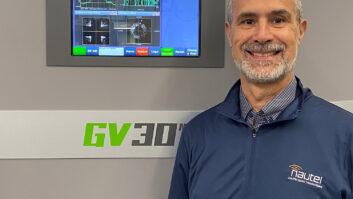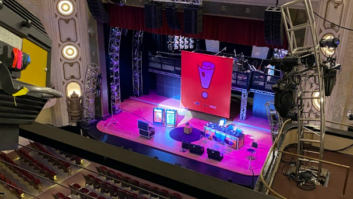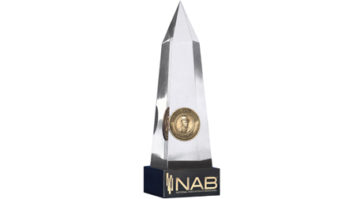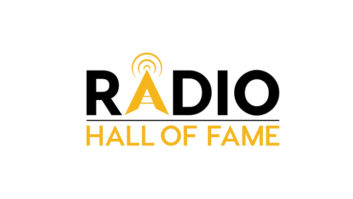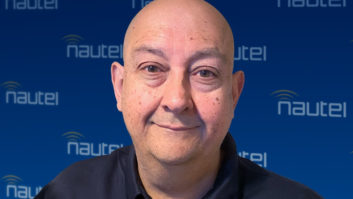
As evidenced by this RCA photo, Wendell Morrison was definitely a “hands-on” engineer.
Credit:
Photo courtesy The David Sarnoff Library Ever hear of an “Antennalyzer?”
No, I’m not referring to the popular little boxes used by ham operators to check antenna characteristics and impedance matching, but rather to an early analog computing device designed in the 1940s by Wendell C. Morrison, a career engineer at the Radio Corporation of America.
While Morrison was closely involved with a lot of broadcast product-related engineering work, including the development of a backwardly compatible color television system, it was his “Antennalyzer” that created headlines, not only in broadcast engineering trade publications, but even in popular magazines.
Simply put, the Antennalyzer was a device that took much of the drudgery out of designing multi-tower directional antenna systems for AM radio.
DIRECTIONAL ANTENNAS
It wasn’t long after radio entered the home in the early 1920s that broadcasting became very popular — actually suicidally popular, as so many players raced to get a signal on the air that they crowded existing spectrum and began to drown each other out. The government stepped in, but the only solutions that could be offered to keep some semblance of peace were limiting licenses and helping broker time-sharing agreements that allowed multiple entities to use a common frequency on a rotating basis.
A more eloquent approach for keeping broadcaster signals separated had to wait a few years. This was in the form of a highly directional transmitting antenna or multi-antenna array.

Morrison’s Antennalyzer was announced to the world in late 1945 and was featured in a cover story in RCA’s “Broadcast News” magazine. Directional arrays got their start in the early 1930s, with the first recorded installation occurring at WFLA in Clearwater, Fla. Some frequency sifting by the Federal Radio Commission put both WFLA and Milwaukee’s WTMJ on a common frequency, and while all was fine in the daytime, skywave interference from WFLA eroded WTMJ’s nighttime coverage, eventually leading to a court challenge. WFLA either had to curtail nighttime broadcasting or cut power rather drastically. The WFLA/WTMJ case was just the tip of a rapidly growing iceberg, as more and more stations attempted to squeeze into the already crowded medium wave spectrum.
That radio signals could interfere with each other either constructively or destructively was nothing new then, but it took the ingenuity of Raymond Wilmotte, an engineer at the United Kingdom’s National Physical Laboratory, to make a practical application of this principle. He was brought in as a consultant to assist WFLA in maintaining its nighttime coverage, and he designed and implemented the first directional array at that station.
It should be noted that the move from conventional horizontally oriented “flattop” and “cage” transmitting antennas to vertical radiators by broadcasters in the early 1930s enabled radiation patterns to be tailored fairly easily. Individual antenna elements could be spaced apart, angular relationships between them established and networks created for sending RF current with differing intensities and phase relationships to these radiating elements. This vertical radiator technology trend was used to advantage by Wilmotte in the WFLA installation.
As the 1930s ended, AM directional arrays had become commonplace, allowing new stations to take to the air and existing ones to increase operating power without worries of interference to co-channel neighbors. As a result, consulting firms were called upon to engineer increasingly tighter and uniquely shaped patterns, mandating the use of more and more radiating elements.
NO FINGER MATH HERE
To appreciate what consultants had to cope with in producing their designs, it’s time to introduce the multivariable equation that has to be solved to construct a directional array. As set forth in the fifth edition of the “NAB Engineering Handbook,” the mathematical expression for calculating directional antenna parameters for a two-tower array is given as:

Where:
E= The inverse field strength at one mile in mV/m
E2= The inverse field strength at one mile for each tower acting alone in mV/m

= The spacing from a reference point midway between the two towers in degrees
Φ= The azimuth angle in degrees measured clockwise from the line of towers

=The electrical “time phase” of tower #2 and the negative “time phase” of tower #1 (in degrees)
The handbook notes that this directional antenna equation only shows what’s happening in the horizontal plane and that the terms were specially defined to simplify the equation. It further notes that an assumption is made that tower heights are equal and that the spacing from tower #1 to tower #2 (S2) and the phase value (Ψ2) is the phase of the current in tower #2 with respect to that in tower #1.
This is the number crunching necessary for just a two-stick array; each additional radiator brings in its own multivariable equation, making the math progressively more onerous.

Morrison’s analog computer was constructed with more than 50 vacuum tubes. This block diagram submitted with his patent application for the device provides some insight into how it worked.
Note too that in the late 1930s and early ‘40s, the only tools available for number crunching were pencil and paper, slide rules and printed trig tables. If you or your firm were well-heeled, then there may have been a Marchant mechanical calculator available to speed some of the math ordeal. However, these were limited to addition, subtraction, multiplication and division; no trig functions or powers.
Given these tools, it could take an engineer anywhere from days to several weeks to do all the math involved in designing a multi-tower array (and to double check it).
In trying to make the directional design task a little easier, a few individuals created mechanical or electro-mechanical “computers” for generating antenna patterns, with changes in tower spacing/angular position and RF current intensity/phase relationship simulated through the use of gears and chains or pulleys and belts.
The designer of one such machine was Carl E. Smith, a Cleveland-based consultant and chief engineer/vice president of radio station WHK. Smith was also one of the authors of the Standard Broadcast Antenna Systems chapter in the “NAB Engineering Handbook.”
He described his work with the mechanical computer/plotter in his book “Directional Antenna Patterns”: “Due to the lack of systemized directional antenna patterns an electro-mechanical calculator was completed prior to World War II. In the fall of 1941, the machine was completed and the work was started to systemize two and three tower directional patterns.”
Smith generated and cataloged several thousand “model” patterns and these formed the basis for his book.
He observed, “It is believed that if the patterns in this book are used merely as a guide to show trends, and not necessarily to show precise patterns that the systematization will have served its purpose.”
In other words, the directional designer could use one of the polar plots generated by these early systems and try to fit it into what he or she wanted to accomplish in terms of an antenna pattern.
ENTER WENDELL MORRISON
While Smith’s mechanical computer speeded up the work of the directional array design, there was still a lot of effort required just to go through the printed patterns to find one that “might” fit your particular need and there was still a lot of work to do to go from a textbook pattern to the equation solving needed to derive the numbers needed to actually construct the array and build the phasor. (Also, Smith kept his information to himself early on — he didn’t get around to publishing his book until 1958.)
It remained for someone else to move this directional design from gears and chains to electronic circuits. That individual was RCA’s Wendell C. Morrison and the “Antennalyzer.”
Exactly where his device got its start may be debatable.
George H. Brown, one of the movers and shakers at RCA’s Camden, N.J. broadcast division, recalls in his autobiography “And Part of Which I Was”: “During the war [WWII] I thought of a batch of electrical signals which were identical in form with the equation of a directional antenna. After World War II, I asked Wendell Morrison, because his skill with electronic circuitry far exceeded mine, to develop and construct an analogue device which followed my concept and which I named ‘Antennalyzer.’ The result was an instrument with knobs for each of the variables of the equation for as many as five tower antennas with the radiation pattern displayed on the face of a cathode-ray tube.”
It may have been Brown who hit upon the idea of moving from the world of gears and pulleys to vacuum tubes and potentiometers, but it took Wendell Morrison to make it happen.
Brown admitted that he did not possess the circuit design skills required for translating equations to wired connections and handed off the task to Morrison. The latter accepted the challenge and eventually produced a device to do what Brown had envisioned.
He filed for a patent on the new design tool, calling it rather deceptively just a “Computing Device.”

For its time, the Antennalyzer was such a revolutionary device that it moved out of the world of scholarly journals and onto the pages of “popular” magazines. His device became known as the “Antennalyzer” and consisted of a large box containing 50+ vacuum tubes and an array of front-panel pots. It was connected to a CRT display device that painted waveform changes brought about by manipulations of the Antennalyzer controls as a polar pattern on the tube. Its operation was almost deceptively simple.
As described by Brown: “When one twisted the knobs at random, a myriad of liriodendron-shaped figures were produced. The operator first traced the desired pattern on the face of the cathode-ray tube with a crayon and then adjusted the knobs at random but with a little skillful insight until the cathode-ray trace coincided with the crayon markings. Then the positioning of the knobs gave the location of the tower antennas and all of the other operating parameters.”
Morrison’s electronic computer made life much, much easier for the antenna designer. This was reflected by Brown as he recalled designing the directional array for Norfolk, Va., station WTAR in 1935.
“As a test of the instrument [Antennalyzer], we traced the WTAR pattern, 10 years too late, on the cathode-ray tube and asked a young lady who was then my secretary to adjust the knobs to achieve the desired coincidence of the traces. In less than 15 minutes she had a perfect match and the readings on the knobs agreed with the numbers which I had produced so arduously 10 years earlier.”
REVOLUTIONARY, BUT NOT A GAMECHANGER
While Morrison’s invention was certainly revolutionary, it was not destined to put the antenna designers out of business.
News of the device formed the cover story for the June 1946 issue of RCA’s house publication “Broadcast News.”
While praising the Antennalyzer, the publication’s editor noted: “Incidentally, Brown and Morrison are very modest about the possibilities of the Antennalyzer. They don’t think it will put consultants out of business, or even make mechanical computers obsolete … The idea is that the Antennalyzer should be used to determine approximately the type of array required to produce the desired pattern — after which a mechanical computer would be used to determine the exact constants. …
“At the present time it is not our intention to manufacture Antennalyzers for sale since it is felt that the cost would be prohibitive. However, one of the two which have been built in Dr. Brown’s Laboratory will be set up at Camden and will be for the use of consultants and other qualified engineers.”
True to the editor’s words, the Antennalyzer never became a stock item in RCA’s catalog of broadcast gear; however it did lead the way out of the use of slide rules and mechanical calculators and into modern digital computers for designing directional arrays.
Today, consulting firms use a number of software programs to crank out multi-tower designs in a matter of minutes on ordinary PCs.
IT’S STILL ALL ABOUT PROTECTING YOUR NEIGHBORS
However, as explained by John Hidle, a consulting engineer with the Carl T. Jones engineering firm, today, just as in Morrison and Brown’s time, calculating antenna array values is not really the most difficult part of designing a directional array.
“The most critical and time-consuming part of the process remains in establishing protection requirements that you need in fitting in the directional pattern,” Hidle said. “This still requires a lot of time and has to be done by the engineer with the computer’s assistance. If someone came to me and said he desired to build a directional AM station in a particular location, the actual time for calculating the array values wouldn’t take long. However, it could require several days for the engineer to think out how he’s going to set up things in establishing protection requirements.”
Nonetheless, Morrison’s analog computer was something of a watershed event when it was revealed to the engineering community and the public at large. The device was written up in the December 1946 “Proceedings of the IRE” for the engineering community and a description of it even made the pages of “Popular Mechanics.”
Morrison remained with RCA for more than 40 years, working at both the company’s Camden, N.J., broadcast division and Princeton research lab, focusing initially on antenna analysis and later UHF transmission and color TV terminal and test equipment products. He served as chief engineer of the broadcast and communications division and also worked in the company’s communications and controls division, as well as the RCA’s defense electronics division.
Morrison was involved heavily in RCA’s early 1950s push to develop a backwardly-compatible color television system and a few years later, in 1956 was part of the team that worked to “reverse engineer” Ampex’s newly developed videotape recorder. (RCA had attempted to develop a VTR of its own, but gave up when Ampex unveiled a much more practical approach to recording video at the 1956 NARTB show. RCA entered into a cross-licensing arrangement with Ampex and used Ampex’s electronic and mechanical designs to develop their own version of the recorder to ensure interchange of recordings between machines produced by both companies.)
Morrison may also have set a record for length of membership in the IEEE and its precursor organization, the Institute of Radio Engineers. That association spanned 72 years. He joined in 1940, became an IEEE Fellow in 1964 and was named a Life Fellow in 1981.
Morrison was 97 when he died in October 2012.
James O’Neal is the technology editor for Radio World’s sister publication TV Technology. He wrote in February about “R.J. Rockwell and His Cathanode Rig.”






